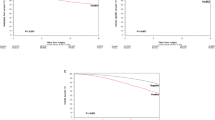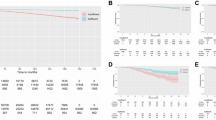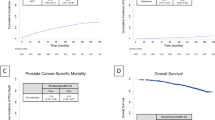Abstract
Background:
Although a positive surgical margin (PSM) at radical prostatectomy (RRP) has been consistently linked to an increased risk of biochemical recurrence, the impact of margin status on patient survival continues to be debated. We evaluated long-term outcomes of patients with a PSM at RRP and determined predictors of systemic progression (SP) and mortality in these men.
Methods:
We reviewed our institutional registry of 16 749 patients who underwent RRP between 1990 and 2008 to identify 2895 patients with a PSM. Median follow-up was 10.6 years. Postoperative survival was estimated using the Kaplan–Meier method. Cox proportional hazard regression models were used to analyze clinicopathological variables associated with SP and death from prostate cancer.
Results:
A 15-year SP-free and cancer-specific survival was 90 and 93%, respectively. On multivariate analysis, higher tumor volume, increased pathological Gleason score and advanced pathological tumor stage were associated with significantly increased risks of SP and death from prostate cancer, whereas number and location of PSM did not predict mortality.
Conclusions:
The risks of SP and prostate cancer death in patients with a PSM remain low on long-term follow-up. Tumor variables are the primary determinants of cancer death. These results should be considered when evaluating patients with a PSM for adjuvant therapy.
This is a preview of subscription content, access via your institution
Access options
Subscribe to this journal
Receive 4 print issues and online access
$259.00 per year
only $64.75 per issue
Buy this article
- Purchase on Springer Link
- Instant access to full article PDF
Prices may be subject to local taxes which are calculated during checkout


Similar content being viewed by others
References
Chang SS, Cookson MS . Impact of positive surgical margins after radical prostatectomy. Urology 2006; 68: 249–252.
Blute ML, Bergstralh EJ, Iocca A, Scherer B, Zincke H . Use of Gleason score, prostate specific antigen, seminal vesicle and margin status to predict biochemical failure after radical prostatectomy. J Urol 2001; 165: 119–125.
Stephenson AJ, Scardino PT, Eastham JA, Bianco Jr FJ, Dotan ZA, DiBlasio CJ et al. Postoperative nomogram predicting the 10-year probability of prostate cancer recurrence after radical prostatectomy. J Clin Oncol 2005; 23: 7005–7012.
Bolla M, van Poppel H, Collette L, van Cangh P, Vekemans K, Da Pozzo L et al. Postoperative radiotherapy after radical prostatectomy: a randomized controlled trial (EORTC trial 22911). Lancet 2005; 366: 572–578.
Thompson IM, Tangen CM, Paradelo J, Lucia MS, Miller G, Troyer D et al. Adjuvant radiotherapy for pathologically advanced prostate cancer. JAMA 2006; 296: 2329–2335.
Wieder JA, Soloway MS . Incidence, etiology, location, prevention, and treatment of positive surgical margins after radical prostatectomy for prostate cancer. J Urol 1998; 160: 299–315.
Grossfeld GD, Chang JJ, Broering JM, Miller DP, Yu J, Flanders SC et al. Impact of positive surgical margins on prostate cancer recurrence and the use of secondary cancer treatment: data from the CaPSURE database. J Urol 2000; 163: 1171–1177.
Vis AN, Schröder FH, Van der Kwast TH . The actual value of the surgical margin status as a predictor of disease progression in men with early prostate cancer. Eur Urol 2006; 50: 258–265.
Boorjian SA, Karnes RJ, Crispen PL, Carlson RE, Rangel LJ, Bergstralh EJ et al. The impact of positive surgical margins on mortality following radical prostatectomy during the prostate specific antigen era. J Urol 2010; 183: 1003–1009.
Mann MJ, DeCastro GJ, Desai M, Benson MC, McKiernan JM . Predictive significance of surgical margin status after prostatectomy for prostate cancer during the PSA era. Urology 2008; 72: 1203–1207.
Epstein JI . Incidence and significance of positive margins in radical prostatectomy specimens. Urol Clin North Am 1996; 23: 651–663.
Simon MA, Kim S, Soloway MS . Prostate specific antigen recurrence rates are low after radical retropubic prostatectomy and positive margins. J Urol 2006; 175: 140–144.
Swindle P, Eastham JA, Ohori M, Kattan MW, Wheeler T, Maru N et al. Do margins matter? The prognostic significance of positive surgical margins in radical prostatectomy specimens. J Urol 2005; 174: 903–907.
Karakiewicz PI, Eastham JA, Graefen M, Cagiannos I, Stricker PD, Klein E et al. Prognostic impact of positive surgical margins in surgically treated prostate cancer: multi-institutional assessment of 5831 patients. Urology 2005; 66: 1245–1250.
Eastham JA, Kuroiwa K, Ohori M, Serio AM, Gorbonos A, Maru N et al. Prognostic significance of location of positive margins in radical prostatectomy specimens. Urology 2007; 70: 965–969.
Ward JF, Blute ML, Slezak J, Bergstralh EJ, Zincke H . The long-term clinical impact of biochemical recurrence of prostate cancer 5 or more years after radical prostatectomy. J Urol 2003; 170: 1872–1876.
Roehl KA, Han M, Ramos CG, Antenor JA, Catalona WJ . Cancer progression and survival rates following anatomical radical retropubic prostatectomy in 3478 consecutive patients: long-term results. J Urol 2004; 172: 910–914.
Freedland SJ, Humphreys EB, Mangold LA, Eisenberger M, Dorey FJ, Walsh PC et al. Risk of prostate cancer-specific mortality following biochemical recurrence after radical prostatectomy. JAMA 2005; 294: 433–439.
Boorjian SA, Thompson RH, Tollefson MK, Rangel LJ, Bergstralh EJ, Blute ML et al. Long-term risk of clinical progression after biochemical recurrence following radical prostatectomy: the impact of time from surgery to recurrence. Eur Urol 2011; 59: 893–899.
Albertsen PC, Hanley JA, Gleason DF, Barry MJ . Competing risk analysis of men aged 55 to 74 years at diagnosis managed conservatively for clinically localized prostate cancer. JAMA 1998; 280: 975–980.
Pfitzenmaier J, Pahernik S, Tremmel T, Haferkamp A, Buse S, Hohenfellner M . Positive surgical margins after radical prostatectomy: do they have an impact on biochemical or clinical progression. BJU Int 2008; 102: 1413–1418.
Wright JL, Dalkin BL, True LD, Ellis WJ, Stanford JL, Lange PH et al. Positive surgical margins at radical prostatectomy predict prostate cancer specific mortality. J Urol 2010; 183: 2213–2218.
Bostwick DG, Myers RP, Oesterling JE . Staging of prostate cancer. Semin Surg Oncol 1994; 10: 60–72.
Amling CL, Bergstralh EJ, Blute ML, Slezak JM, Zincke H . Defining prostate specific antigen progression after radical prostatectomy: what is the most appropriate cut point? J Urol 2001; 165: 1146–1151.
Stephenson AJ, Kattan MW, Eastham JA, Dotan ZA, Bianco Jr FJ, Lilja H et al. Defining biochemical recurrence of prostate cancer after radical prostatectomy: a proposal for a standardized definition. J Clin Oncol 2006; 24: 3973–3978.
Jayachandran J, Bañez LL, Levy DE, Aronson WJ, Terris MK, Presti Jr JC et al. Risk stratification for biochemical recurrence in men with positive surgical margins or extracapsular disease after radical prostatectomy: results from the SEARCH database. J Urol 2008; 179: 1791–1796.
Resnick MJ, Canter DJ, Guzzo TJ, Magerfleisch L, Tomaszewski JE, Brucker BM et al. Defining pathological variables to predict biochemical failure in patients with positive surgical margins at radical prostatectomy: implications for adjuvant radiotherapy. BJU Int 2009; 105: 1377–1380.
Budäus L, Isbarn H, Eichelberg C, Lughezzani G, Sun M, Perrotte P et al. Biochemical recurrence after radical prostatectomy: multiplicative interaction between surgical margin status and pathologic stage. J Urol 2010; 184: 1341–1346.
Alkhateeb S, Alibhai S, Fleshner N, Finelli A, Jewett M, Zlotta A et al. Impact of positive surgical margins after radical prostatectomy differs by disease risk group. J Urol 2010; 183: 145–150.
Stephenson AJ, Wood DP, Kattan MW, Klein EA, Scardino PT, Eastham JA et al. Location, extent and number of positive surgical margins do not improve accuracy of predicting prostate cancer recurrence after radical prostatectomy. J Urol 2009; 182: 1357–1363.
Van der Kwast TH, Bolla M, Van Poppel H, Van Cangh P, Vekemans K, Da Pozzo L et al. Identification of patients with prostate cancer who benefit from immediate postoperative radiotherapy: EORTC 22911. J Clin Oncol 2007; 25: 4178–4186.
Dillman RO, Hafer R, Cox C, McClure SE . Overall survival benefit from postoperative radiation therapy for organ-confined, margin-positive prostate cancer. Int J Radiat Oncol Biol Phys 2011; 79: 719–723.
Boorjian SA, Karnes RJ, Crispen PL, Rangel LJ, Bergstralh EJ, Blute ML . Radiation therapy after radical prostatectomy: impact on metastases and survival. J Urol 2009; 182: 2708–2714.
Trock BJ, Han M, Freedland SJ, Humphreys EB, DeWeese TL, Partin AW et al. Prostate cancer-specific survival following salvage radiotherapy vs observation in men with biochemical recurrence after radical prostatectomy. JAMA 2008; 299: 2760–2769.
Stephenson AJ, Shariat SF, Zelefsky MJ, Kattan MW, Butler EB, Teh BS et al. Salvage radiotherapy for recurrent prostate cancer after radical prostatectomy. JAMA 2004; 291: 1325–1332.
Wiegel T, Bottke D, Steiner U, Siegmann A, Golz R, Störkel S et al. Phase III postoperative adjuvant radiotherapy after radical prostatectomy compared with radical prostatectomy along in pT3 prostate cancer with postoperative undetectable prostate-specific antigen: ARO96-02/AUO AP 09/95. J Clin Oncol 2009; 27: 2924–2930.
Thompson IM, Tangen CM, Paradelo J, Lucia MS, Miller G, Troyer D et al. Adjuvant radiotherapy for pathological T3N0M0 prostate cancer significantly reduces risk of metastases and improves survival: long-term followup of a randomized clinical trial. J Urol 2009; 181: 956–962.
Mehta SS, Lubeck DP, Sadetsky N, Pasta DJ, Carroll PR . Patterns of secondary cancer treatment for biochemical failure following radical prostatectomy: data from CaPSURE. J Urol 2004; 171: 215–219.
Author information
Authors and Affiliations
Corresponding author
Ethics declarations
Competing interests
The authors declare no conflict of interest.
Rights and permissions
About this article
Cite this article
Boorjian, S., Tollefson, M., Rangel, L. et al. Clinicopathological predictors of systemic progression and prostate cancer mortality in patients with a positive surgical margin at radical prostatectomy. Prostate Cancer Prostatic Dis 15, 56–62 (2012). https://doi.org/10.1038/pcan.2011.36
Received:
Revised:
Accepted:
Published:
Issue Date:
DOI: https://doi.org/10.1038/pcan.2011.36
Keywords
This article is cited by
-
Length of positive surgical margins after radical prostatectomy: Does size matter? – A systematic review and meta-analysis
Prostate Cancer and Prostatic Diseases (2023)
-
Long-term oncological outcomes of apical positive surgical margins at radical prostatectomy in the Shared Equal Access Regional Cancer Hospital cohort
Prostate Cancer and Prostatic Diseases (2016)
-
Disease-specific outcomes of Radical Prostatectomies in Northern Norway; a case for the impact of perineural infiltration and postoperative PSA-doubling time
BMC Urology (2014)



